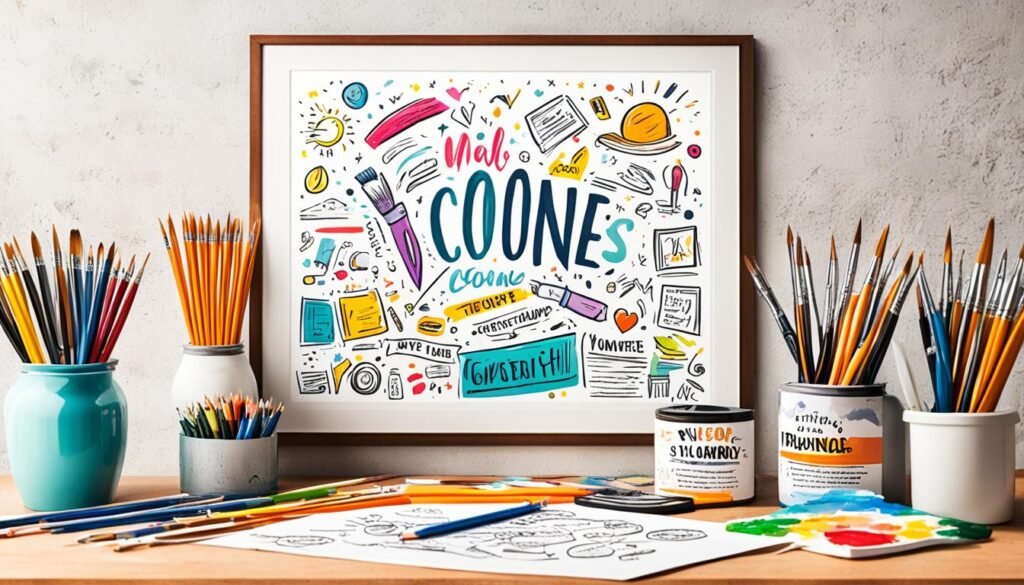How to Foster a Creative Environment at Home
Nurturing creativity in children is key for their growth. By creating a creative space, we encourage them. We also provide the tools for them to express their imaginations and ideas.
A dedicated area for creativity is crucial. This might be a spot in the living room or a desk in their bedroom. It could even be a whole playroom. Fill it with art supplies, puzzles, and more to ignite their creativity.
Show your child different creative activities they can try. This may include painting, drawing, or making things with LEGOs. Let them try and learn as they explore. With this freedom, their creativity will blossom.
Take your child to places that engage all their senses. Museums and botanical gardens are great examples. Exposing them to different sights and sounds boosts their creative thinking.
Let your child play freely without strict rules. This allows them time to dream and think creatively. Supporting their explorations and ideas is crucial for their independence and creativity.
Help them, but also let them do things their way. Support and guide, but let them express their unique ideas. Ask questions to encourage critical thinking and reflection.
Key Takeaways:
- Create a designated creative space at home that is filled with art supplies and materials.
- Provide examples and hands-on projects to spark your child’s creativity.
- Engage all their senses through outings and experiences.
- Allow for unstructured playtime to encourage independent thinking.
- Balance your involvement and support with giving them freedom to express themselves.
The Importance of Creativity at Home
Creativity at home matters a lot for a child’s growth. It helps in many ways, making a child’s life better.
Key Benefits of Fostering Creativity
- Develops Problem-Solving Skills: Encouraging creativity lets kids think in new ways. They learn to solve problems with creative solutions.
- Enhances Critical Thinking Abilities: Creative activities boost critical thinking. Kids learn to look at situations from different viewpoints and make smart choices.
- Cultivates Resilience: Being creative helps kids deal with failure. They learn from their mistakes and keep trying.
- Encourages Self-Expression: Creative outlets let children show their ideas and feelings in special ways.
- Boosts Confidence: Creativity makes kids feel good about what they can do. They see their work as valuable.
- Stimulates Intellectual Development: Creative activities improve brain connections. This makes kids smarter, helps them remember more, and think better.
- Fosters Innovation and Adaptability: Creativity teaches kids to be innovative and ready for change. They learn to do well in a world that’s always changing.
“Creativity is intelligence having fun.” – Albert Einstein
Promoting creativity helps children not just now, but for the future too. It supports their learning, the desire to explore, and ways to show their art.
An Inspiring Example
“When I was young, I had art supplies at home. My parents always cheered my creative side. This shaped my art skills and gave me the confidence to do graphic design. Today, I’m successful, and it’s all thanks to my parents for encouraging creativity early on.” – Emily Johnson, Graphic Designer
When creativity is central at home, it helps kids in many ways. This guide will point out simple ways to encourage creativity with your kids.
Designating a Creative Space
Setting up a creative corner in your house is key to sparking imagination in kids. This area reminds them it’s okay to think outside the box. It’s a spot made especially for their creative adventures.
Choose a spot that’s easy to get to and helps with being artsy. It might be a playroom, a nook in the kitchen, or the backyard. Wherever it is, the goal is to fill it with ideas and dreams.
Fill your creative zone with stuff that boosts imagination. Art supplies like paint, brushes, or markers are a must. Add in crafty bits, building sets, and puzzles too. They all push your child to explore and create.
| Must-Have Supplies for a Designated Creative Space | Benefits |
|---|---|
| Art supplies (paints, brushes, colored pencils, markers) | Allow children to express their creativity through different artistic mediums. |
| Craft supplies (glue, scissors, paper, beads) | Promote fine motor skills and provide opportunities for hands-on creativity. |
| Building blocks and puzzles | Enhance problem-solving and cognitive skills while fostering spatial awareness. |
Keep this space neat and well-organized. It should be easy for your child to find their tools. A tidy space can bring a sense of peace and lets creativity shine.
Having a special creative area at home is like planting a seed for your child’s mind. It’s a place that celebrates creative thinking. Encourage their visits to this spot. You’ll surely see their ideas blooming.
Providing Examples and Encouraging Hands-on Projects
A blank page can seem scary and stop kids from being creative on their own. This is why showing kids examples of projects, pictures, or videos is key. It helps children start thinking creatively. They become more eager and sure about their own ideas when they see what’s possible.
Getting kids to do hands-on projects is also great for their creativity. Activities like working with paper, beads, paints, LEGOs, and clay help them learn new ways to express themselves and solve problems. This approach teaches kids to be more creative and think differently.
“By giving kids examples and getting them to do hands-on projects, we help them find their creative spark and explore how they like to be artistic.”
When kids work on hands-on projects, they get better at thinking and solving problems. They develop important skills by using different materials and methods. Exploring these ways helps them see their work turning into something. This can make them want to try more and become even more creative.
Making hands-on projects a part of daily life for kids is easy. You can have regular times for these activities or add them to schooling at home or other activities. Making creativity daily helps kids naturally want to be imaginative and express themselves in art.
Benefits of Providing Examples and Encouraging Hands-on Projects:
- Sparks creativity and imagination
- Boosts confidence in creative abilities
- Develops problem-solving and critical thinking skills
- Enhances adaptability and innovation
- Provides a tangible outlet for self-expression
- Motivates children to keep exploring and experimenting
Parents and caregivers have a big part in encouraging creativity through examples and hands-on projects. This way, kids learn to find their own creative style. They also pick up important skills and grow more confident in expressing their ideas. With support and guidance, kids can truly bring out their creative side and enjoy art forever.
Going Beyond Paper and Crayons
Helping kids be creative means giving them many tools and materials. This goes beyond paper and crayons. It opens up new worlds for their creativity.
From robotics kits and 3D printers to beads, sequins, and sewing machines, many options are out there. These creativity-sparking tools let kids use different things and learn new ways to create. Robotics kits teach problem-solving, and 3D printers let kids make their designs real. These tools make learning fun and open up a world of discovery.
Not all creativity needs fancy gadgets though. Things like newspapers, magazines, play-doh, markers, chalk, and paint kits help too. They let kids freely express themselves and think of new ideas. Magazines and play-doh are great for making art. Markers, chalk, and paints help kids play with colors and textures.
“By giving kids many different materials, parents can really spark their creativity. This helps them learn a lot of different things.”
| Material | Benefits |
|---|---|
| Robotics Kits | Encourages problem-solving and critical thinking |
| 3D Printers | Brings designs to life, fosters innovation |
| Beads and Sequins | Enhances fine motor skills and creativity |
| Sewing Machines | Allows for fabric creations, stimulates imagination |
| Newspapers and Magazines | Source of inspiration, encourages collage art |
| Play-doh, Markers, Chalk, and Paint Kits | Explores different textures and techniques, encourages artistic expression |
Parents can build a creative space by offering many materials. The mix of innovative materials and creativity-sparking tools is key. It gives kids what they need to follow their creative dreams. The blend of tech and classic arts creates a space where kids can be creative. They get to share their ideas and make their dreams come true.
Activating All the Senses
Activating all senses is crucial for sparking creativity. It’s through various sensory experiences that children’s interest and imagination grow. To enhance these abilities, it’s good to take kids to places rich in different stimuli.
For instance, libraries are perfect for quiet thinking and imaginative ideas. Zoos, with exotic animals, are great for the eyes and ears. And in parks, children can feel grass, smell flowers, and truly explore.
Museums and botanical gardens are full of experiences for the senses. The colors and textures of art in museums pave the way for new thoughts. Likewise, botanical gardens smell amazing and offer vibrant scenery for the eyes.
Science centers are ideal for hands-on learning, through touch, sight, and sound. These places trigger interest and learning, making kids curious in fun ways.
By appealing to every sense, children approach creativity in a well-rounded way. They find beauty and inspiration around them. It encourages them to see things from many angles in their art and ideas.
Benefits of Engaging the Senses
“The more we engage the senses, the more we stimulate imagination and creativity in children.”
Invigorating the senses benefits creativity and learning in children. It helps them in many ways:
- It makes them curious
- It sharpens their focus
- It pushes them to explore and try new things
- It boosts their creative problem-solving
- It connects them deeper to their environment
These sensory experiences open the door to creativity. They encourage children to dream up new things and express themselves in art. Engaging their senses creates a fertile space for creative growth.
| Sensory Experiences | Benefits |
|---|---|
| Visiting libraries | Encourages deep thinking and imagination |
| Exploring zoos | Stimulates visual and auditory senses |
| Adventuring in parks | Offers tactile experiences and exposure to nature |
| Visiting museums | Provides visual inspiration through artwork |
| Exploring botanical gardens | Engages multiple senses, including smell and sight |
| Interacting with science centers | Encourages hands-on experiments and learning |
Allowing for Free Time and Unstructured Play
Fostering creativity in kids is key. It’s crucial to give them unstructured time for play and exploration. Today, many kids are super busy with lots of planned activities. This makes it hard for them to just play freely. Yet, this free time is when their creativity shines the most.
Unstructured play is all about being free to do what they want. Kids can create, try new things, and solve problems on their own. It helps build their imagination and lets them be themselves. This kind of play is not held back by rules or goals. It’s about pure exploration.
Kids can let their minds run wild during unstructured play. Everything around them is a tool for their creative adventures. This can be through games, pretend stories, or even making art. These activities let their creativity burst out. They’re not just having fun; they’re learning to create in their own way.
“Unstructured play is crucial for kids. It lets them experiment and come up with new ideas. When kids play freely, they’re the ones in charge. This freedom helps boost their creativity and how they express themselves.” – Dr. Jane Adams, Child Psychologist
Moms and dads play a vital role in promoting free and creative play. By supporting unstructured play, they value their kids’ creative spirit. Kids learn to think critically and solve problems. This prepares them for the future, where they’ll face many choices.
It’s all about balance. Both structured and unstructured time are important. While plans and classes are good for learning, kids also need time to simply play. Giving them this time helps them grow their creative side and enjoy exploring.
Benefits of Unstructured Play
Unstructured play has a lot of advantages for kids:
- It boosts creativity and imagination
- Helps with solving problems and critical thinking
- Makes them more independent and better at making choices
- Teaches them to be resilient and adaptable
- It encourages them to express who they are
- Builds their self-confidence
In the end, unstructured play is about letting kids be free to learn through fun. It’s about the joy of discovery and embracing creativity for life.
Balancing Involvement and Independence
Finding the right mix between helping and letting kids be on their own is key to spark creativity. Yes, guiding and supporting is important. But, too much parent help can block a child’s path to fully show their creativity. It can also slow down their journey to gain self-reliance.
It’s best to let kids own their creative work. Then, offer a hand only when they ask. This way, kids can really shine creatively and grow confident.
“The role of parents in nurturing creativity is not about directing every step of the process, but rather providing a nurturing environment where children can freely explore their ideas and imagination.”
Letting children do things on their own builds their skills to solve problems, think critically, and feel independent. It’s about letting them figure things out by themselves. This process helps kids bounce back from mistakes, which in turn strengthens their ability to think and act positively.
By helping kids be creative, parents lay the groundwork for them to show who they are. This journey also helps children find what really matters to them. Striking the right balance helps kids take charge of their creativity. They move ahead with confidence, knowing their parents are there to back them up.
Fostering Confidence
Encouraging kids to run creatively free boosts their confidence. They feel proud of their work and ideas. This pushes them to try new creative adventures boldly.
Kids learn a lot from taking risks and facing failures. It makes them not just more creative but also stronger overall. And these are skills they’ll take far in life.
It’s not just about what they make, but the journey they take to get there. Parents playing their part to applaud that journey helps kids aim high. This inspires kids to keep pushing, tap into their full creativity, and share who they are without fear.
| Benefits of Balancing Involvement and Independence | Guiding Principles |
|---|---|
| 1. Encourages self-expression and individuality | 1. Provide support when needed |
| 2. Promotes problem-solving and critical thinking skills | 2. Allow children to take ownership of their projects |
| 3. Builds resilience and a growth mindset | 3. Emphasize process over outcome |
| 4. Fosters confidence and a sense of pride | 4. Encourage risk-taking and learning from failures |
Encouraging Questioning and Reflection
Asking open-ended questions about a child’s projects boosts their critical thinking. Parents can say, “How did you think of that?” or “What made you start this project?” It leads kids to think more deeply and find fresh ideas.
Asking questions helps kids analyze and come up with new ideas. It makes them look at things in different ways. This way, they learn to think creatively and flexibly.
“What parts of your project do you think went well? And how could you make it better?”
Thoughtful questions get children thinking. They make them understand their work better. Such questions also push kids to consider other ways of doing things and the results of their choices.
Questioning and reflecting help in developing a child’s thinking about their work. This kind of self-analysis makes them want to do better. It helps them take charge of their creativity.
Approaches for Encouraging Questioning and Reflection:
- Ask kids about the creative process, the materials they used, or why they did the project.
- Get them to think about what they’ve done and how they can make it better.
- Ask them to imagine different things to encourage them to be creative.
These methods help kids know their creativity better and think critically. They learn to keep exploring, welcome new ideas, and grow more sure and smart about their work.
Supporting and Encouraging Passions
Every child has unique interests. Parents can help by supporting these passions. This provides a chance for kids to be creative in their own way.
Children shine when they follow what makes them happy. So, parents, listen to what excites your child. Let them share their dreams and ideas with you freely.
It’s also important to give kids the tools they need for their hobbies. For instance, if your child loves art, make sure they have paints and brushes. If they’re into music, help them find a class or a space to play.
Supporting their passions means celebrating their successes, too. Boosting their confidence with praise can make a big difference.
Showing passion in your own interests inspires them. It shows kids the joy in pursuing what you love.
Encouraging these passions helps children find their voice. They learn to be themselves in the things they love. This boosts their confidence and creativity.
Example: Supporting a Child’s Passion for Music
“My daughter loves music. We got her piano lessons and a keyboard. She has a special spot in our home for her music. We go to concerts together, which she loves. Music has made her more confident and focused.”
Benefits of Supporting Children’s Passions
| Benefits | Description |
|---|---|
| Enhanced creativity | Being passionate leads kids to think creatively and try new things. |
| Increased motivation | Kids’ drive to learn grows when they follow their passions. |
| Improved self-confidence | A hobby that they do well in boosts their belief in themselves. |
| Expanded knowledge | Diving into interests helps children learn more about the world. |
Encouraging interests helps kids grow. It sparks their creativity and helps them find their talents. Parents playing an active role in this help in their child’s overall development.

Discussing Personal Creative Processes
Parents can really spark their children’s creativity by sharing how they get creative. They should talk openly about how they think of new ideas and solve problems. This helps kids see that being creative is tied to hard work and never giving up. It also helps build a stronger bond between them.
When parents talk about how they’ve handled tough creative spots, kids learn not to give up. They get motivated to tackle their own creative projects with strength and grit. This insight helps kids understand the ups and downs of being imaginative.
Parents have a chance to show children where they find inspiration. They should share their own ways of staying inspired. This tells kids that being creative is not just about ideas – it’s a journey too. A journey into a world full of chances and choices.
“I always find inspiration in nature. Taking long walks in the park or going hiking helps me clear my mind and lets the ideas flow. It’s important to find what inspires you and make time for it.” – Parent
Parents also let their kids in on different creative ways they like. Like painting, writing, or taking photos. This helps children see there are many paths to artistic creativity. It encourages them to find their own art forms.
This sharing creates a space for kids to talk about their creative dreams. It makes a strong connection between parents and their children. A place where creativity is cheered and supported.
By sharing their creative paths, parents really help their kids. They empower them to think creatively and not be afraid of new ideas. Children learn that being creative is a journey they can proudly own. It’s about exploring, discovering, and showing their unique selves to the world.
Conclusion
Creating a creative space at home is key to developing your child’s artistry. Set up an area just for this, filled with examples and support for their projects. It helps kids unleash their creativity. Engage their senses and give them free time to experiment.
Encouraging your child’s interests is crucial. Talk about their creative processes. This helps them grow their own ideas. Building a creative home environment sets the stage for better self-expression and thinking skills.
In short, a creative home motivates kids to think outside the box. It prepares them for a future where creativity is a valuable asset. Such an environment shapes their journey toward success.








